By M Reyaz, TwoCircles.net,
Ajmer: At the revered Jannati Darwaza (Gateway to Heaven) in the shrine of Hazrat Khwaja Moinuddin Chishty as the devotees throng to tie the sacred thread, a Khadim (Servant) is invoking the faithful to make wishes and offerings: “Aate jaao, maangte jaao, dete jaao.”
The pilgrimage to the holiest shrine of the most revered Sufi in South Asia, Khwaja Moinuddin Chishty is often reduced to a chaotic trip for most visitors, where in ‘coercive’ tone of sugar-coated politeness the cartel of Khadims seek money at every step.
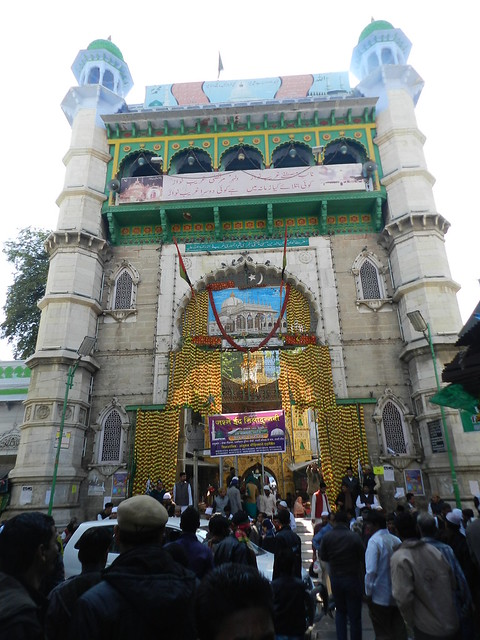
What was supposed to be a voluntarily nazrana (offering) at the shrine has been reduced into almost ‘coerced’ ritual of the zyarat (pilgrimage), not at one place but on several occasions, apparently for maintenance of the shrine, and for the mass feast (langad), as well as the service of respective Duwagos (Khadims of the Mazar) for the “satisfactory - spiritual services” (Dua) rendered, as well as for the fulfilment of wishes, for the services offered as guide, and for charity made in general.
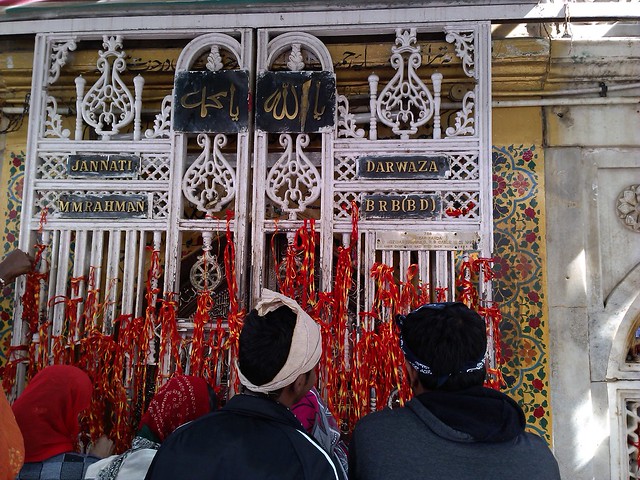
Jannati Darwaza
At the Mazar of Bibi Sahiban (Wives of Sufi Saint), as I lowered my gaze to see the tombs from the marbled ventilator, a Khadim puts his hand on my head and invokes me to make offering after pretending to hum the prayer and seek forgiveness. When I start taking out a ten rupees note, he ‘politely’ asks for at least hundred.
As you proceed the water carrier, Bhishti, with their traditional leather bags, would ask you for money for doing the service of providing ‘holy’ water for washing away sins and illness and cleansing the soul. Not really a believer in these sham rituals, I attempt to proceed, but as many of them encircle me, I give in, and hand out another note to them.

Mazar of Bibi Sahiban (Wives of Hazrat Khwaja Moinuddin Chishty)
The shrine of Gharib Nawaz is crowded on most days, and hence like a tour guide, it helps if you are with a Khadim as that would save you time from standing in queue. Besides, like a true Khadim of Dargah many of them help you through the spiritual journey and in all fairness these Khadims survive on these nazranas. However, what is of concern is that there appears to be no accoutnabilty of the huge sum collected at different places.
(Syed Suhail Chishty)
The puritan form of Islam – the Salafis, as well as the Deobandis of South Asia - deride the Sufi cult following, and consider it as biddath (addition to religion), while for the followers Sufism, the ‘holy’ soul of the enlightened and beloved saints figuratively becomes a ladder to reach out to the Almighty. At the Dargah of the revered Khwaja Gharib Nawaz the ‘ladder’ appears to be chaotic at best, or an intricate network crony tour guides, masquerading to be Khuddam (plural of Khadim), at worst.
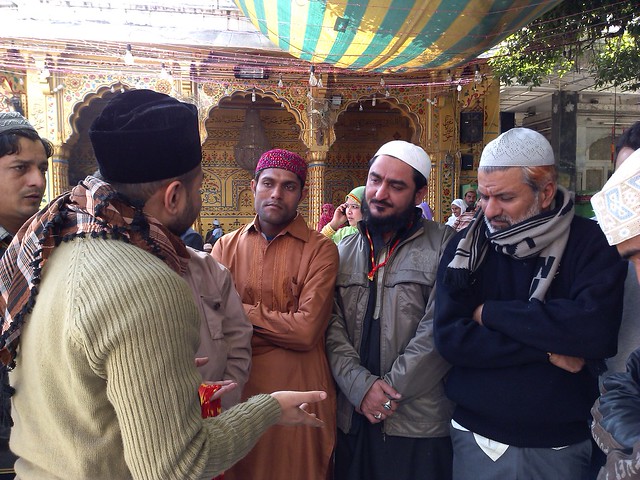
A Khadim explaining to the devotees the importance of sacrifices.
During the medieval period, the so called ‘Dark Age’ in Europe, Churches had virtually started selling off Indulgence, a certificate of remission of temporal punishment, one of the ‘malpractices’ against which the likes of Martin Luther protested, beginning the new branch of ‘Protestant’ Churches, as well as leading the ‘counter-reformation’ in Catholicism. Back home, anyone who has visited the bigger temples or dhams, would better associated with the experiences one has in unarguably the biggest Dargah in the country.
Even at the Beghami Dalan (Queen’s courtyard named so as it was commissioned by Mughal Queen Noor Jahan), or at the exit door of the Dome that houses the most revered tomb, Khadims stand for collecting ‘offerings.’
Who is a Khadim?
Khadims claim to be descendants of Hazrat Khawaja Syed Fakhruddin Gurdezi, a cousin and follower of Khwaja Gharib Nawaz. Syed Sultan Hassan Chishty, one such Khadim, tells TCN that their families have been serving the house of Khwaja Gharib Nawaz for nine hundred years now. There is an estimate 5000 Khadims at the moment from around 2000 families.
(Syed Sultanul Hassan Chishty)
Though never directly mentioned, it is made out that without the Nazrana, the wishes would never be granted. A simple Google search of Ajmer Dargah or Khwaja Gharib Nawaz throws out websites of different houses of Khuddam, who exhort the faithful to donate money “anytime from anywhere in form of offering.” What is interesting that most of these websites have personal bank account details and not in the name of any organisation.
One such website, run by Haji Shah Syed Shah Nawaz Chishty offers to make lodging and other arrangements in the guest house made especially for the devotees. Most of the guest houses in the locality are run by family members of Khadims, or other committees.
What was more surprising that the Nazrana was openly being collected and even receipt given out at the Anjuman office. As this this Correspondent visited the Anjuman office, soon a horde of pilgrims was escorted to deposit the offerings for the community work.
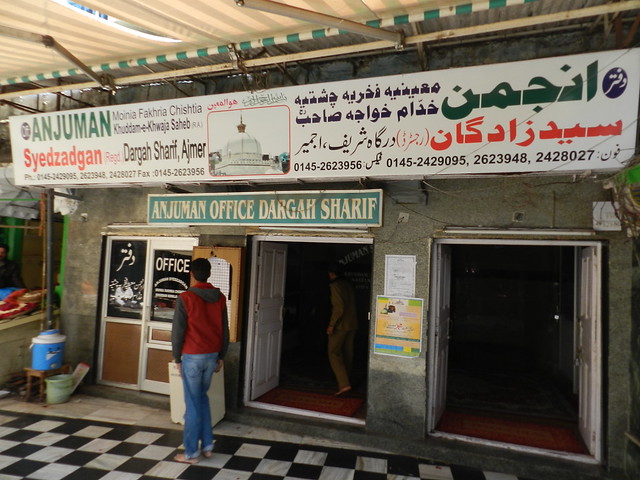
The receipt notes the purpose of the offerings made in bold letters, “Nazar-O-Niyaz of Huzoor Khwaja Gharib Nawaz (R.A.).” Overleaf, also mentions the purported charitable works, done by one such Anjuman (there are two Anjumans of Khadims). Anjuman Moinia Fakhria Chishtia Khuddam Khwaja Sahib Syedsadgan, a registered body under the Societies Act, says that the offerings made are utilised for charitable works like providing stipend to widows, scholarships to students, medical help, and for celebrating several Islamic occasions. They even run schools and madrassas.

At the office of Anjuman, offerings are 'officially' made with receipts.
In April 2012, then Pakistan’s President Asif Ali Zardari had visited the 13th century shrine and made an offering of one million dollars (over 5 crore rupees then) for the welfare of the Dargah. Similarly each time some leaders or celebrities come they donate big sum of money to the Anjuman.
The critics of Khadims, however, argue that most of these offerings go into their pockets. Although no one TCN spoke to wanted to be named, but some very respected people who closely watch the functioning of Dargah bodies alleged the benefactors of most of the schemes too are the family members of the Khadims.
The court yard of the shrine campus, particularly the eastern flank, appears to have been divided into smaller stalls or locations for each group of Khadmis, for them manage their clients – the devout Muslims, who visit the shrine to pay homage and to make wishes.
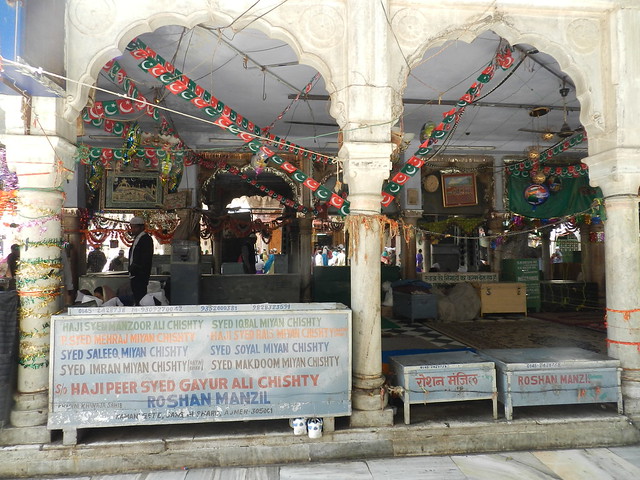
Like a tour guide they make arrangements for this spiritual journey, however, thy are not organised. Although Anjuman exists the services rendered by most individual Khadims appear to be unregulated.
Take the example of the Deg (big cauldron) donated by Mughal Emperor Jahagir; in the name of preparing Langad (community feast), each day devotees make offerings. Although no one was willing to talk on record, our sources say that the Deg is auctioned amongst the Khadims by the Anjuman for a fixed amount for a fixed tenure and the excess of money goes into their pockets.
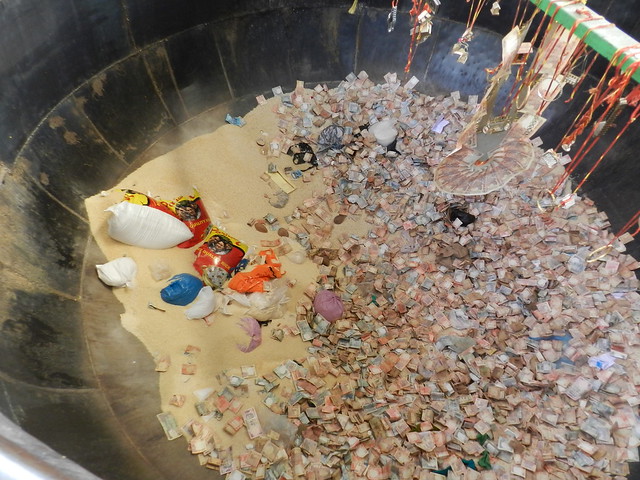
Badi Degh
There have also been reported cases of misbehaviour, cheating, even allegations of rape on individual Khadims. But it would be unfair to brand all the Khadims. Surely there are many devout Khadims, who are serving the community and the Dargah. However, most fail on the question of accountability.
Role of Government and Dargah Committee: The government too is responsible for the mess in the Dargah. Ajmer Shrine is managed by a special Act of Parliament known as Dargah Khwaja Sahab, Act 1955, under which a 9-member Dargah Committee nominated by the Central Government, including a Nazim (CEO).
The 1955 Act clearly mentions that it is the responsibility of the Committee to collect endowments and to make its proper use, besides managing the Dargah and other properties. Khadims are supposed to be paid by the Committee, and they need to undergo certain basic training in Islamic teachings as per the law. There are several criteria, like they should not be less than 40 years of age, etc.

Some of the provisions have been challenged in different courts on many occasions by Khadims, but the court has so far upheld them. Some of cases are still pending in different courts, including the Apex Court.
There are 395 properties of Dargah Sharif including Shops (163), Houses (14), Godwons (07), Plots (98), Tehkhana (03), Rooms (49), Floors (04), Quarters (36) and Cabins (21). Out of this 72 are under litigations whereas 67 are lying vacant for future Developmental Activities. There are 21 pieces of agriculture land measuring 18.5 Hectares as well.
However, the Committee has failed to deliver so far for fear of attracting the wrath of the Khadims, who certainly outnumber them. The battle for the rights over Dargah properties, its endowments and associations are in fact three ways amongst the Dewan of Dargah, the direct descendants of Gharib Nawaz, Khadims and the government appointed Committee. The battle over rights between Sajjadanashin (The Custodian) and Khadims are quite old that have reached several courts.
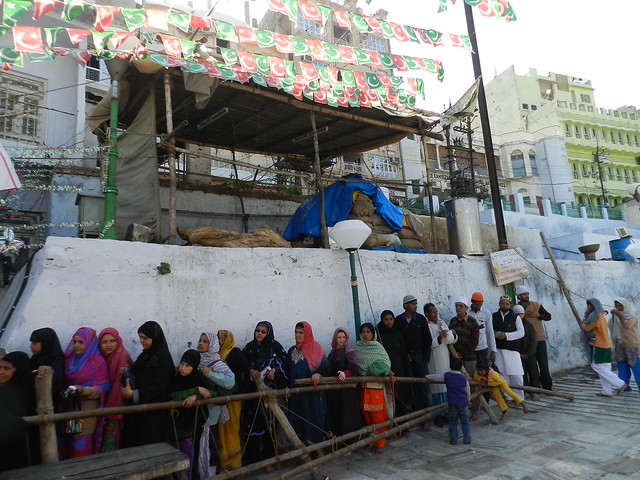
Queue for langad
Meanwhile, both the Anjuman of Khadims and Committee pat their own backs for organising the Urs, Chadar, langad (community feast).
Willingly looking the other side?
What is more shocking that no one is willing to talk on the issue for the fear of “hurting the religious sentiments.” In 2012, when allegation of misuse of Dargah fund surfaced, then Minister of Minority Affairs Salman Khurshid had told a newspaper that he is concerned about "irregularities and mismanagement" of the shrine, but advised to trade cautiously. “You must understand that it's a religious place and that's why we are very cautious to take action on these complaints. In the past, some action taken by the ministry was construed as direct intervention into the affairs of the shrine which is revered by people," he then said.
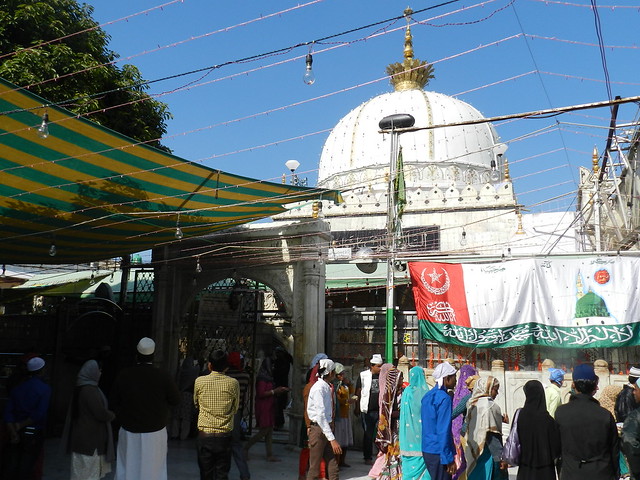
When TCN contacted the current Dewan Syed Zainul Abedin Ali Khan, successor and Sajjadanashin (Custodian) of the Dargah of Khwaja Moinuddin Chishty, he refused to comment on the subject.
A reputed Delhi based author who has written several books on Sufism too refused to comment when contacted, saying, “Why do you want to present the Dargah in poor light by highlighting certain negative issues,” adding, “There are some black sheep everywhere.”
[Photos & video interview by Mudassir Rizwan, TwoCircles.net]
Ajmer: At the revered Jannati Darwaza (Gateway to Heaven) in the shrine of Hazrat Khwaja Moinuddin Chishty as the devotees throng to tie the sacred thread, a Khadim (Servant) is invoking the faithful to make wishes and offerings: “Aate jaao, maangte jaao, dete jaao.”
The pilgrimage to the holiest shrine of the most revered Sufi in South Asia, Khwaja Moinuddin Chishty is often reduced to a chaotic trip for most visitors, where in ‘coercive’ tone of sugar-coated politeness the cartel of Khadims seek money at every step.

What was supposed to be a voluntarily nazrana (offering) at the shrine has been reduced into almost ‘coerced’ ritual of the zyarat (pilgrimage), not at one place but on several occasions, apparently for maintenance of the shrine, and for the mass feast (langad), as well as the service of respective Duwagos (Khadims of the Mazar) for the “satisfactory - spiritual services” (Dua) rendered, as well as for the fulfilment of wishes, for the services offered as guide, and for charity made in general.

Jannati Darwaza
At the Mazar of Bibi Sahiban (Wives of Sufi Saint), as I lowered my gaze to see the tombs from the marbled ventilator, a Khadim puts his hand on my head and invokes me to make offering after pretending to hum the prayer and seek forgiveness. When I start taking out a ten rupees note, he ‘politely’ asks for at least hundred.
As you proceed the water carrier, Bhishti, with their traditional leather bags, would ask you for money for doing the service of providing ‘holy’ water for washing away sins and illness and cleansing the soul. Not really a believer in these sham rituals, I attempt to proceed, but as many of them encircle me, I give in, and hand out another note to them.

Mazar of Bibi Sahiban (Wives of Hazrat Khwaja Moinuddin Chishty)
The shrine of Gharib Nawaz is crowded on most days, and hence like a tour guide, it helps if you are with a Khadim as that would save you time from standing in queue. Besides, like a true Khadim of Dargah many of them help you through the spiritual journey and in all fairness these Khadims survive on these nazranas. However, what is of concern is that there appears to be no accoutnabilty of the huge sum collected at different places.
(Syed Suhail Chishty)
The puritan form of Islam – the Salafis, as well as the Deobandis of South Asia - deride the Sufi cult following, and consider it as biddath (addition to religion), while for the followers Sufism, the ‘holy’ soul of the enlightened and beloved saints figuratively becomes a ladder to reach out to the Almighty. At the Dargah of the revered Khwaja Gharib Nawaz the ‘ladder’ appears to be chaotic at best, or an intricate network crony tour guides, masquerading to be Khuddam (plural of Khadim), at worst.

A Khadim explaining to the devotees the importance of sacrifices.
During the medieval period, the so called ‘Dark Age’ in Europe, Churches had virtually started selling off Indulgence, a certificate of remission of temporal punishment, one of the ‘malpractices’ against which the likes of Martin Luther protested, beginning the new branch of ‘Protestant’ Churches, as well as leading the ‘counter-reformation’ in Catholicism. Back home, anyone who has visited the bigger temples or dhams, would better associated with the experiences one has in unarguably the biggest Dargah in the country.
Even at the Beghami Dalan (Queen’s courtyard named so as it was commissioned by Mughal Queen Noor Jahan), or at the exit door of the Dome that houses the most revered tomb, Khadims stand for collecting ‘offerings.’
Who is a Khadim?
Khadims claim to be descendants of Hazrat Khawaja Syed Fakhruddin Gurdezi, a cousin and follower of Khwaja Gharib Nawaz. Syed Sultan Hassan Chishty, one such Khadim, tells TCN that their families have been serving the house of Khwaja Gharib Nawaz for nine hundred years now. There is an estimate 5000 Khadims at the moment from around 2000 families.
(Syed Sultanul Hassan Chishty)
Though never directly mentioned, it is made out that without the Nazrana, the wishes would never be granted. A simple Google search of Ajmer Dargah or Khwaja Gharib Nawaz throws out websites of different houses of Khuddam, who exhort the faithful to donate money “anytime from anywhere in form of offering.” What is interesting that most of these websites have personal bank account details and not in the name of any organisation.
One such website, run by Haji Shah Syed Shah Nawaz Chishty offers to make lodging and other arrangements in the guest house made especially for the devotees. Most of the guest houses in the locality are run by family members of Khadims, or other committees.
What was more surprising that the Nazrana was openly being collected and even receipt given out at the Anjuman office. As this this Correspondent visited the Anjuman office, soon a horde of pilgrims was escorted to deposit the offerings for the community work.

The receipt notes the purpose of the offerings made in bold letters, “Nazar-O-Niyaz of Huzoor Khwaja Gharib Nawaz (R.A.).” Overleaf, also mentions the purported charitable works, done by one such Anjuman (there are two Anjumans of Khadims). Anjuman Moinia Fakhria Chishtia Khuddam Khwaja Sahib Syedsadgan, a registered body under the Societies Act, says that the offerings made are utilised for charitable works like providing stipend to widows, scholarships to students, medical help, and for celebrating several Islamic occasions. They even run schools and madrassas.

At the office of Anjuman, offerings are 'officially' made with receipts.
In April 2012, then Pakistan’s President Asif Ali Zardari had visited the 13th century shrine and made an offering of one million dollars (over 5 crore rupees then) for the welfare of the Dargah. Similarly each time some leaders or celebrities come they donate big sum of money to the Anjuman.
The critics of Khadims, however, argue that most of these offerings go into their pockets. Although no one TCN spoke to wanted to be named, but some very respected people who closely watch the functioning of Dargah bodies alleged the benefactors of most of the schemes too are the family members of the Khadims.
The court yard of the shrine campus, particularly the eastern flank, appears to have been divided into smaller stalls or locations for each group of Khadmis, for them manage their clients – the devout Muslims, who visit the shrine to pay homage and to make wishes.

Like a tour guide they make arrangements for this spiritual journey, however, thy are not organised. Although Anjuman exists the services rendered by most individual Khadims appear to be unregulated.
Take the example of the Deg (big cauldron) donated by Mughal Emperor Jahagir; in the name of preparing Langad (community feast), each day devotees make offerings. Although no one was willing to talk on record, our sources say that the Deg is auctioned amongst the Khadims by the Anjuman for a fixed amount for a fixed tenure and the excess of money goes into their pockets.

Badi Degh
There have also been reported cases of misbehaviour, cheating, even allegations of rape on individual Khadims. But it would be unfair to brand all the Khadims. Surely there are many devout Khadims, who are serving the community and the Dargah. However, most fail on the question of accountability.
Role of Government and Dargah Committee: The government too is responsible for the mess in the Dargah. Ajmer Shrine is managed by a special Act of Parliament known as Dargah Khwaja Sahab, Act 1955, under which a 9-member Dargah Committee nominated by the Central Government, including a Nazim (CEO).
The 1955 Act clearly mentions that it is the responsibility of the Committee to collect endowments and to make its proper use, besides managing the Dargah and other properties. Khadims are supposed to be paid by the Committee, and they need to undergo certain basic training in Islamic teachings as per the law. There are several criteria, like they should not be less than 40 years of age, etc.

Some of the provisions have been challenged in different courts on many occasions by Khadims, but the court has so far upheld them. Some of cases are still pending in different courts, including the Apex Court.
There are 395 properties of Dargah Sharif including Shops (163), Houses (14), Godwons (07), Plots (98), Tehkhana (03), Rooms (49), Floors (04), Quarters (36) and Cabins (21). Out of this 72 are under litigations whereas 67 are lying vacant for future Developmental Activities. There are 21 pieces of agriculture land measuring 18.5 Hectares as well.
However, the Committee has failed to deliver so far for fear of attracting the wrath of the Khadims, who certainly outnumber them. The battle for the rights over Dargah properties, its endowments and associations are in fact three ways amongst the Dewan of Dargah, the direct descendants of Gharib Nawaz, Khadims and the government appointed Committee. The battle over rights between Sajjadanashin (The Custodian) and Khadims are quite old that have reached several courts.

Queue for langad
Meanwhile, both the Anjuman of Khadims and Committee pat their own backs for organising the Urs, Chadar, langad (community feast).
Willingly looking the other side?
What is more shocking that no one is willing to talk on the issue for the fear of “hurting the religious sentiments.” In 2012, when allegation of misuse of Dargah fund surfaced, then Minister of Minority Affairs Salman Khurshid had told a newspaper that he is concerned about "irregularities and mismanagement" of the shrine, but advised to trade cautiously. “You must understand that it's a religious place and that's why we are very cautious to take action on these complaints. In the past, some action taken by the ministry was construed as direct intervention into the affairs of the shrine which is revered by people," he then said.

When TCN contacted the current Dewan Syed Zainul Abedin Ali Khan, successor and Sajjadanashin (Custodian) of the Dargah of Khwaja Moinuddin Chishty, he refused to comment on the subject.
A reputed Delhi based author who has written several books on Sufism too refused to comment when contacted, saying, “Why do you want to present the Dargah in poor light by highlighting certain negative issues,” adding, “There are some black sheep everywhere.”
[Photos & video interview by Mudassir Rizwan, TwoCircles.net]

No comments:
Post a Comment